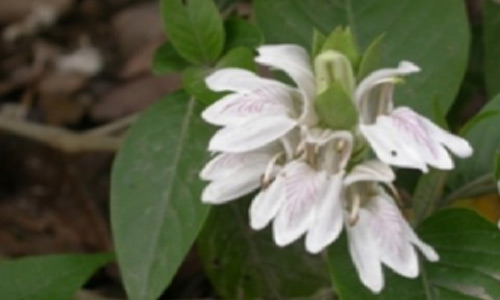|
Division
|
Angiosperms |
|
Class
|
Dicotledons |
|
Subclass |
Gamopetalae |
|
Series |
Hypogynae |
|
Order |
Lamiales |
|
Family
|
Acanthaceae |
|
Genus
|
Adhatoda |
|
Species
|
zeylanica |

|
Etymology: |
In Tamil ‘Adu’, means goat, and ‘toda’ not touching; referring to the pungent qualitries of leaves. |
|
Botanical name
|
Adhatoda zeylanica Medik. (A. vasica Nees.) |
|
Local/Trade names:
|
Bansa, Arusa. |
|
Conservation status:
|
Wild throughout India. |
|
Digonestic features: |
Capsule clavate. |
|
Description: |
Erect shrub, upto 1.5 m high. Leaves 6-13 x 2.3-5 cm, elliptic-lanceolate or lanceolate, base altenuate. Flowers white, with pink-purpose stripes, in dense axillary spikes. Capsule 2 cm long, clavate, brown. |
|
Phenology: |
Almost throughout the year. |
|
Distribution:
|
Throughout India. |
|
Where to see it: |
Medicinal Plant Nursery. |
|
Uses: |
Fresh or dried leaves constitute the drug vasaka, used in bronchial troubles and consumption. Leaf juice used also in diarrhoea, dysentery and glandular tumours. Powdered leaves used for skin affections. Chief principle is vasicine (yield, 0.54-1.1%). Vasicine has also been found to be a promising uterotonic abortifacient. It may also find use in stopping postpartum haemorrhage. Leaves are rich in Vitamin C (upto 250 mg/100g) and carotine (4500ug/100g) and yield an essential oil. Flowers also contain an essential oil. Seeds yield a fatty oil. Plant is employed as a green manure. Ether extract of the leaves yields a resin which is toxic to grain insects, but non-toxic to human beings. Wood used for gunpowder charcoal. |
Chief Conservator of Forests & Chief Wildlife Warden is the Head of the Department. There is one post of Conservator of Forests & two posts of Deputy Conservator of Forests viz.